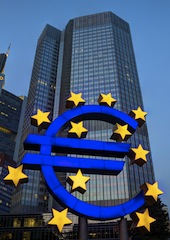European Blame Games: A 20-Year Retrospective
What lessons can be drawn from a big crisis 20 years ago to help overcome the current malaise in Europe?
August 6, 2013

Twenty years ago, the European exchange rate mechanism (ERM) — the central part of the old European Monetary System which was the forerunner of economic and monetary union (EMU) — was in disarray.
Only the radical step of a drastic widening of the exchange rate bands, agreed on August 2, 1993, rescued the system.
A wave of turbulence that had started innocuously enough with a depreciation of the Finnish markka, was followed by the British and Italian departures from the ERM.
It all ended in an unprecedented crisis which shook Europe’s monetary framework to the core. Fortunately, this also proved to be a milestone on the road to monetary union.
Two decades on, the question for present-day Europe is this: What lesson can be drawn from the events of 20 years ago to help overcome the current malaise in Europe?
Many people say that the root cause of the crisis was that German unification altered the business cycle in Germany.
That historic event, in purely economic terms, prolonged an already strong expansion in then West Germany which forced the Bundesbank to raise interest rates.
The action of the German central bank coincided with recession elsewhere, most particularly in the UK.
It is difficult to deny the role of German unification in spurring the crisis. However, confining the discussion to Germany alone would be wrong.
The basic reasons for the 1992-93 crises lay elsewhere. In early 1987, the Europeans abandoned the wise rule of small but rather frequent adjustments in ERM exchange rates. Subsequently, in the absence of full economic convergence, imbalances started to accumulate.
Furthermore, new countries joined the system in spite of not even being close to convergence with ERM core economies.
All the same, their currencies performed well. Up to June 1992, the Spanish peseta and the Portuguese escudo were at the top of the ERM’s “parity grid” of bilateral exchange rates.
Denial that anything was amiss, and resistance to recognize faults in the system, went hand in hand. In the wake of the UK’s ERM exit in September 1992, a bitter dispute arose between the UK and Germany over the causes of the debacle.
The UK’s unwillingness to listen to its European peers when it joined the ERM in October 1990 was one of the reasons for the mishap. But the problem went beyond the UK — as France found less than a year later.
The drastic widening of the ERM bands on 2 August — from 4.5% to 30% — was greeted with disbelief and even mockery. Many commentators thought this was a trick aimed to disguise the de facto depreciation of some ERM currencies.
The widening of the band was accompanied by a certain discord. The Netherlands and Germany opted to remain with the old band (of +/-2.25%), confirming their dualism among ERM members.
Not surprisingly, 20 years later, the Netherlands and Germany are among the only two countries to preserve their triple-A credit status.
The drastic widening was not enough to prevent further realignments. Spain and Portugal had to devalue their currencies yet again.
The lesson was that, no matter how flexible a certain framework may be, maintaining it depends on the country’s willingness to exert control on its domestic economy.
Today in Europe, those who hope that the European Central Bank’s so far unused OMT bond-buying program would somehow work miracles have to bear this lesson in mind.
In 1993, Europe was submerged in recession. The recovery was rather lengthy and was built around relatively quick fiscal consolidation.
Europe’s economic vulnerability was exposed in 1995 when markets temporarily lost faith in the dollar. At that time it was already clear that the first deadline (1997) to introduce the euro was beyond reach.
Europe had to launch its currency at the later date, in 1999. The Europeans were aided by the re-appreciation of the dollar, which helped them reach their goal.
It is difficult to select winners and losers from the ERM crisis. Many countries depreciated their currencies against the Deutsche Mark, and this took its toll on the Germans.
Costs stemming from unification, together with an overvalued currency, had launched Germany on a path to becoming “the sick man of Europe.”
This apparent illness had far reaching effects. In early 1998, the Germans were determined to bring Italy into the nascent currency area, in spite of not being totally convinced about the sustainability of Italian convergence.
Tipping the argument was the fear of letting Italian exporters gain competitiveness through yet another depreciation of the domestic currency.
The “sickness” of the German economy paved the way to deep structural reforms that were not matched by action in other European countries.
Through a series of meandering routes, this had led us to today’s crisis.
Editor’s note: This article is adapted from OMFIF.org. The author writes here in a personal capacity.
Takeaways
Many people say the root cause of the 1993 crisis was that German unification altered the business cycle.
A bitter dispute arose between the UK and Germany over the causes of the currency management debacle.
The Germans were determined to bring Italy into the nascent euro currency area.
The "sickness" of the German economy led to deep structural reforms there that were not matched elsewhere.
Much depends on any country's willingness to exert control over its domestic economy.
Read previous

A Real Stimulus For Japan
August 5, 2013
